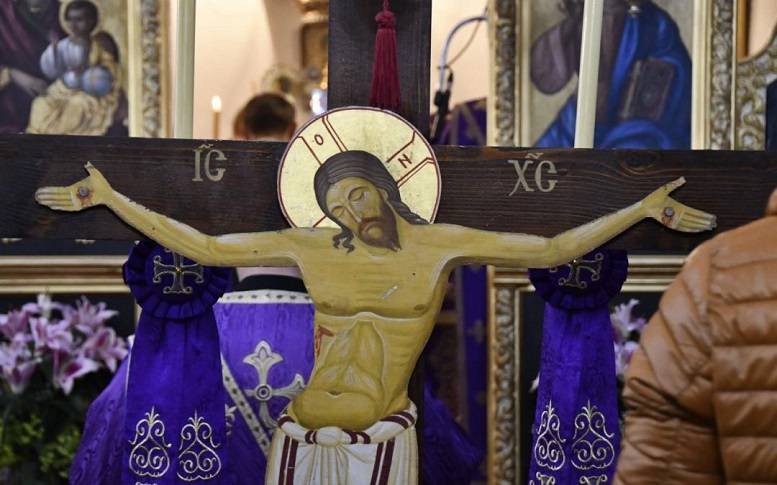
Holy Forty - Happy and God-blessed beginning of Great Lent
Having prepared believers for feats of fasting and repentance, the Church introduces them to the feat itself. The liturgies of Great Lent, as well as the liturgies of the preparatory weeks, constantly encouraging fasting and repentance, describe the state of the soul that repents and weeps for its sins. The external appearance of Lenten services also corresponds to this: during the ordinary days of Lent, with the exception of Saturday and Sunday, the full Liturgy, this most solemn and festive service, is not served in the Church. Instead of the complete Liturgy, the Liturgy of the Presanctified Gifts is served on Wednesdays and Fridays. The composition of other church services changes with the times. On ordinary days of the week, singing almost stops, priority is given to the reading of texts from the Old Testament, especially the Psalter, at all church services the prayer of St. indicating the time until which the daily fast should last.
Holy Pentecost and its liturgies begin from the evening of Syrupus Sunday. Syropus Sunday is still popularly called Forgiveness Sunday, because the act or ritual of mutual forgiveness is performed at the evening service on this day in the temple.
The act of forgiveness is performed in the following way: the icons of the Savior and the Mother of God are brought to the altar and placed on the altar; the abbot makes a prayer in front of them and kisses them, and then usually gives a sermon, asking the clergy and the people for forgiveness of their sins, saying: "Bless me, holy fathers and brothers, and forgive me, a sinner, for I have sinned this day and all the days of my life mine: by letter, deed, thought and all my feelings.» ("Bless me, holy fathers and brothers, and forgive me, a sinner, for what I have sinned today and in all the days of my life: in word, deed, thought and all my feelings.") At the same time, he makes a metania in front of the clergy and the people. All of them also answered him with metania, saying: "God forgive you, holy father." Forgive us, sinners, and bless us." (May God forgive you, holy father. Forgive us, sinners, and bless us.»). Then the abbot takes the penultimate Cross and all the priests in order of seniority kiss the icons on the altar, approach the abbot, kiss the venerable Cross and the hand that holds the Cross, kiss with the abbot. After them, lay people approach, kiss the holy icons and the Cross and ask each other for forgiveness.
During the ceremony of forgiveness, "Pokajanija otverzi mi dveri" ("Repentance open the door to me"), "Na rjekah bavilonskih" ("On the rivers of Babylon") and other penitential songs are usually sung. In some temples, the Easter hymns are also sung, up to the words "and so cry out" ("and so cry out"), including them (in the last hymn).
In accordance with the Gospel words, which are read this week, which speak about the need to forgive one's sins and make peace with everyone, in ancient times Egyptian hermits gathered on the last day of the holy week for joint prayer and begging each other for forgiveness and blessing, with the chanting of Easter verses, in a certain way, a reminder of the expected Resurrection of Christ, after the vespers, they dispersed in the desert for solitary exploits during the Lent and gathered again only for Tsveti. That is why even today, according to the old pious custom, the sons of the Orthodox Church, as a sign of reconciliation and forgiveness, pray for the dead and visit each other during Holy Week.
The first Sunday of Great Lent is characterized by special strictness, because it is appropriate to have a zeal for a pious life at the beginning of the feat. Accordingly, the Church performs longer services during the first week than during the following days. From Monday to Thursday, the penitential canon of Saint Andrew of Crete (+712) is read at the High Supper. This canon is called the Great one, both because of the multitude of thoughts and memories contained in it, and because of the number of tropars, which are about 250 (there are about 30 in ordinary canons). For reading in the first week of Lent, the canon is divided into four parts, according to the number of days.
On Wednesday and Thursday, several tropars are added to the Great Canon in honor of the venerable Mary of Egypt (+522), who came from a deep spiritual decline to sublime piety.
The Great Canon ends with tropars in honor of its creator - St. Andrew of Crete.
On Monday or Tuesday of the first week after matins or classes, the priest reads to the parishioners the "Prayers for the beginning of the fast of the Forty Saints", which are listed in Trebnik.
On Saturday of the first week, the Church remembers the miraculous help that the great martyr Theodore Tiron (around +306) provided to the Christians of Constantinople in the year 362, during the reign of Emperor Julian the Apostate (+363), when the saint, who appeared to the Archbishop of Constantinople, in the first week of Great Lent, commanded to eat koljivo (boiled grains) instead of food defiled by sprinkling the blood of idol victims in the marketplace. The consecration of the manger takes place on Friday of the first week at the Pre-sanctified liturgy, after the alms prayer and chanting of prayers to the Great Martyr Theodore.
In many temples, on Fridays or Sundays, a moving liturgical rite called passion (from the Latin passio - suffering) is performed. It was introduced into church use during the time of the Metropolitan of Kyiv Peter Mogila (XVII century). It is served at dinner (on Friday) or at vespers (on Sunday) of the first, second (often from the second), third and fourth weeks of fasting and consists of the reading of the Gospel about Christ's sufferings, songs of Holy Week - "You, clothed with the world, rizoja" ("You, who have clothed yourself in light, as in robes"), "Come, I will soothe Joseph prisnopamjatnago" ("Come let us call blessed Joseph the unforgettable") and others - and lessons. The passions are not discussed in the church sutav. The act of the passions was first mentioned at the end of the Flower Triod issued in 1702 by the archimandrite of the Kyiv-Pechersk Lavra, Joasaf Kronovski. At the end of the description of the act, it was said: "We remember all this by advice, not by commandment, which is all given to the judgment of the Holy Orthodox Church."
The first Sunday (as a day of the week) of Great Lent is otherwise called the Sunday of Orthodoxy or the Victory of Orthodoxy. On this day, the victory of Orthodoxy is commemorated. It is a custom that was introduced in Byzantium in the first half of the 9th century to commemorate the final victory of the Orthodox Church over all the heretical teachings that troubled the Church, especially over the last of them - iconoclasm, which was condemned at the Seventh Ecumenical Council in 787. On this Sunday, a special service is performed, which is called the act of Orthodoxy. This act was written by Methodius, Patriarch of Constantinople (842-846). The victory of Orthodoxy was celebrated for the first time on the first week of Great Lent, therefore, the basis for celebrating this victory of Orthodoxy is historical.
The act of Orthodoxy mainly consists of prayer chanting and is served in congregate churches after the reading of the hours before the liturgy or after the liturgy, in the middle of the temple, in front of the icons of the Savior and the Mother of God.
The second week and Sunday of Great Lent is called the Sunday of Holy Lent: the Church prays to the Lord for the gracious illumination of those who fast and who repent. At the services of this week and on Sundays, along with contrition for man's sinful state, fasting is praised as a path to inner blessed illumination.
The Orthodox teaching on fasting is especially strongly revealed in the memory, during the second week, of St. Gregory Palamas, Archbishop of Thessaloniki (XIV century). Saint Gregory was a great Athonian ascetic, known as the protector of Orthodoxy and the debunker of the heretical teaching of Varlamus, a Calabrian monk, who rejected the Orthodox teaching about the light of grace, which enlightens the inner man and is sometimes revealed visibly, for example, as it was on Tabor and Sinai. Varlam believed that it was impossible to attain this illumination through prayer, fasting, and other spiritual feats of self-denial. At the Council convened on this occasion in Constantinople in 1341, St. Gregory Palamas, who was called the son of the Divine Light, debunked the heretics and defended the teaching about the Divine Light, uncreated, ever-existing, with which the Lord shone on Tabor and with which they are illuminated ascetics who attain such enlightenment through prayer and fasting.
The church service in honor of Saint Gregory Palamas and his life was written by Philoteus, Patriarch of Constantinople (XIV century), and the canon by Gennadius Sholar (XV century).
The third Sunday of Great Lent is called Adoration of the Cross, because on this Sunday the Church celebrates the Holy Cross and the spiritual fruits of the Savior's death on the cross.
The Church has explained the significance of the Cross of Christ for those who undertake fasting in liturgical songs, in various images and allegories. Like a tree that has many leaves and casts a dense shadow, thus providing shade and rest to a weary traveler, the Cross of Christ in the middle of the feat of fasting provides shade to believers and encourages them to finish their work. The Cross of Christ as a sign of victory over death prepares us for the joyous celebration of the Victor of hell and death. The Cross of Christ is compared to the tree that sweetened the bitter waters of Mera, to the tree of life, which was planted in the middle of paradise. The joyful news about the Cross and bowing to it with consolation remind us of the approaching feast of Christ's Resurrection.
Apart from the celebration of the Holy Cross on which the Lord rested until death, in the liturgies of the fourth Sunday of Great Lent, Pharisaic pride, which was condemned by God, is exposed, and the humility of the tax collector is praised.
Starting from the Wednesday of the Adoration of the Cross Sunday, at the Liturgies of the Preconsecrated Gifts until Holy Wednesday, special litanies are recited for those who are preparing for enlightenment (baptism).
In the services of the fourth Sunday, the Church offers a sublime example of the ascetic life represented by the ascetic from the 6th century, Venerable Jovan Laddervičnik, who lived as an ascetic on Mount Sinai from the age of 17 to 80 and who described in his work "The Ladder of Paradise" the path of man's gradual ascent to spiritual perfection by the ladder of the soul, which leads him from the earth to eternal glory. The "Ladder" lists 30 such steps, according to the number of years of the Savior's earthly life until His entry into social service to mankind.
On Thursday of the fifth week, at matins, the entire Great Canon of St. Andrew of Crete and the life of the Venerable Mary of Egypt (V-VI c.) are read, who rose from the abyss of vice through repentance to such a height of perfection and holiness that she became similar to disembodied angels. This worship service is therefore differently called Mary's (or more rarely: Andrew's) standing. In practice, it is served on Wednesday evening. When reading the Life, it is divided into two parts: one part is read after the catechisms, and the other after the third song of the canon. The Life of the Venerable Mary was written by St. Sophronius, Patriarch of Jerusalem (638-644), and St. Andrew of Crete, who was sent by the Patriarch of Jerusalem Theodore to the VI Ecumenical Council of Trulli (680-681), brought the Life of St. Mary along with his canon. The reading of the canon of St. Andrew and the Life of St. Mary of Egypt on Thursday of the fifth week at matins was established at this Council.
On Wednesday of the fifth week, at vespers, which refers to Thursday, instead of the usual stichers on the "Lord raise" 24 penitential stichers of the Great Canon - the work of St. Andrew of Crete - are sung. All verses end with: "Lord! May the threads not perish until the end, save me.» ("Lord! Before I perish utterly, save me.")
On Thursday, in order to read the Great Canon, the Liturgy of the Presanctified Gifts is celebrated and the ringing of the bell is complete, that is, it is not Lent.
Saturday of the fifth week is called Akathist Saturday, and the service itself was named "Praise to the Blessed Virgin". On this day, the Akathist is read at matins, which in Greek means chanting with which one does not sit, dedicated to the Mother of God in memory of Her intercession and the deliverance of Constantinople during fasting days from the invasion of foreigners in the 7th century. This first akathist was written in the 7th century. on the basis of even older kondaks in which the events of the Nativity of the Lord and the Annunciation to the Most Pure Theotokos are sung.
On the fifth Sunday of Great Lent, the Church remembers Saint Mary of Egypt and celebrates her.
In the songs of the canon for this week, as well as in the services of the weekdays of the next week - flower week, the Gospel story about the rich man and Lazarus is revealed in order to encourage believers to true repentance, which leads to the Kingdom of God. The Church convinces believers to avoid the mercilessness and inhumanity of the rich and to be jealous for the patience and generosity of Lazarus, because the Kingdom of God is not food and drink, but justice and abstinence with holiness and mercy.
On the Saturday of the sixth week - Palm Sunday, the Church remembers the miracle when the Lord Jesus Christ resurrected Lazarus, that is why it is called Lazarus Saturday.
By resurrecting Lazarus, Jesus Christ showed His Divine power and glory and convinced His disciples and everyone of His upcoming resurrection and general resurrection of the dead on the day of God's judgment.
The flowers are dedicated to the memory of the solemn Entry of the Lord into Jerusalem, where he went to suffer and die on the cross. This event was described by all the evangelists: Mt. 21, 1-11; Mk. 11, 1-11; Lk. 19, 29-44; Jn. 12, 12-19. This holiday is called Tsveti, Flower Sunday, and in the colloquial language of Russians, Vrbica Sunday, because of the custom of consecrating palm branches on that day, which in our country are replaced by willow.
The holiday dates back to ancient times. The first indication of the holiday - in the 3rd century, belongs to St. Methodius, Bishop of Patara (+312), who left a lesson for this day. In the 4th century, as St. Epiphanius of Cyprus testifies, the holiday was celebrated very solemnly. Many of the holy fathers from the 4th century left their teachings for this holiday. In the VII-IX Saints Andrew of Crete, Cosmas of Mayum, John of Damascus, Theodore and Joseph the Studite, as well as the Byzantine Emperor Leo the Philosopher, Theophanes and Nicephorus Xanthopulus, celebrated the holiday with songs that the Orthodox Church still sings today.
The Feast of the Entry of the Lord into Jerusalem is one of the twelve greatest feasts of the Lord and the Mother of God, but it has neither the pre-holiday nor the after-holiday, because it is surrounded by the fasting days of Lent and Holy Week. However, although there is no pre-holiday day like the other holidays from the list of the twelve greatest, the services of the entire previous week, starting from Monday, in many verses and tropars are dedicated to the event of the Lord's entry into Jerusalem.
On the Friday of Palm Sunday, the Lent of Holy Forties ends. On this day, in one of the verses on "Godi vozvah", it is sung: "The soul-beneficial people who have completed the Fortieth Sunday, and the holy week of Your Passion, please see it, O Lover of Man."
Lazarus Saturday and Flowers serve as a transition from the Forties to Holy Week.
Source: Pravoslavie. ru
PHOTOS
RELATED ARTICLES
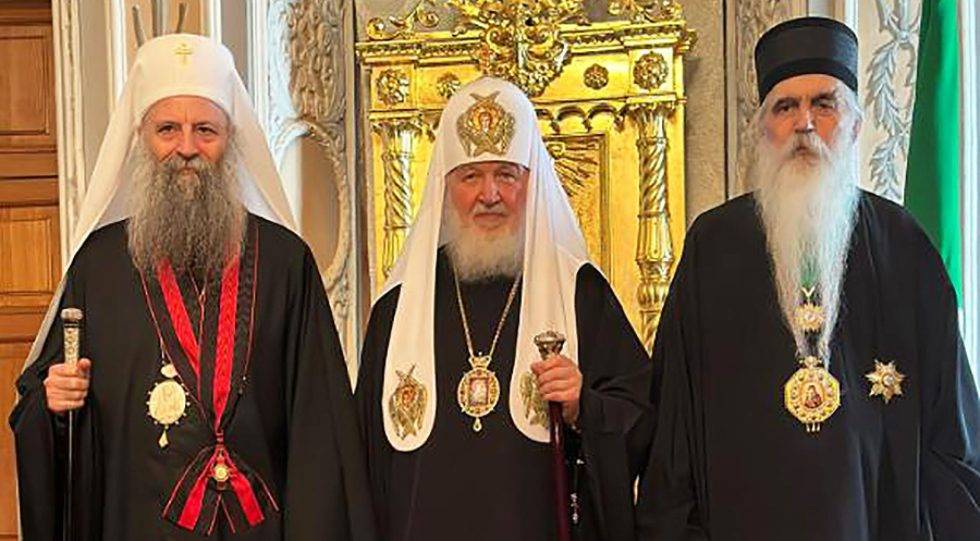
Patriarch Porphyry Awarded the Order of the Holy Equal-to-the-Apostles Prince Vladimir
After the Divine Liturgy in the Assumption Cathedral of the Trinity-Sergius...
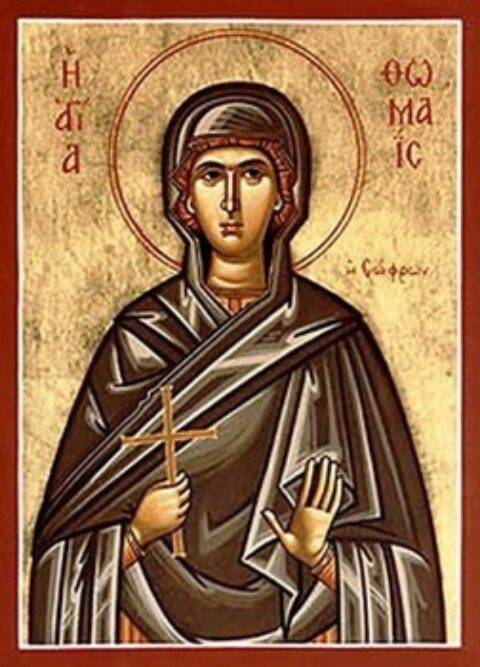
Calendar for April 26 Holy Martyr Thomais
Born in Alexandria of honorable parents; taught piety from a young age and at...
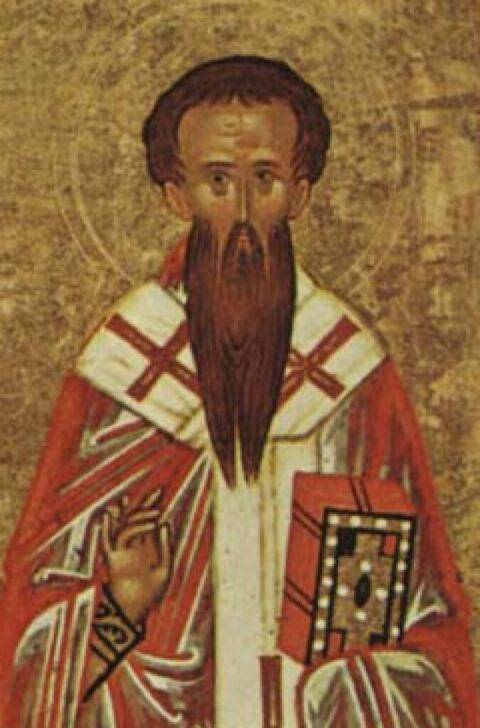
Calendar for April 25 Saint Basil the Confessor – Eastern Friday
A companion and martyr of Saint Procopius the Decapolis. Basil faithfully...


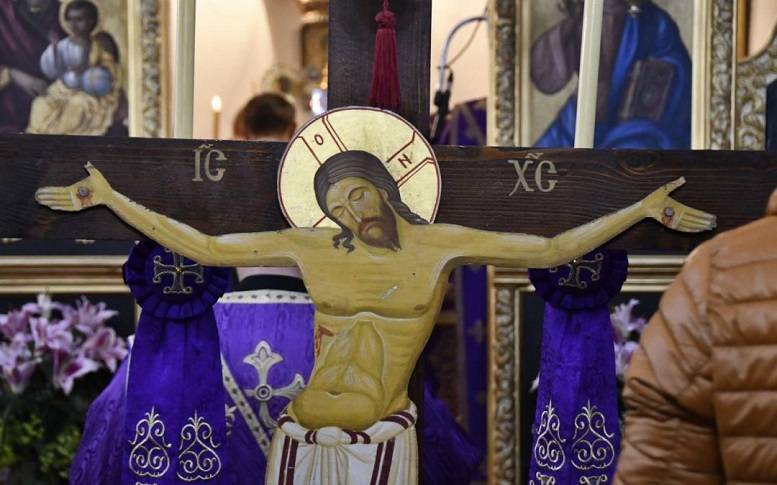

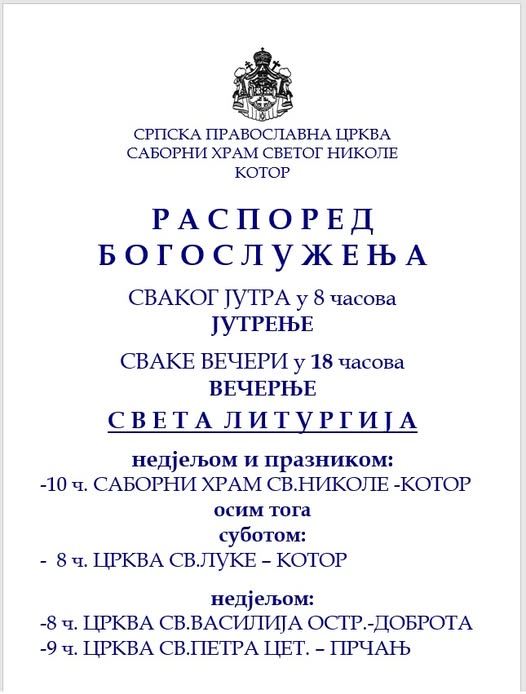
.png)